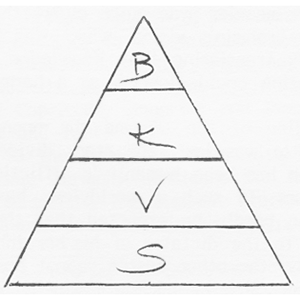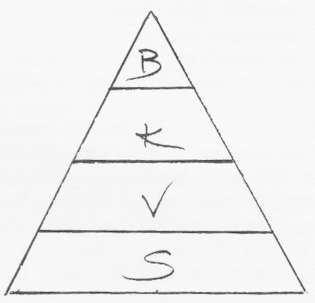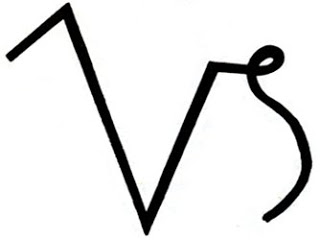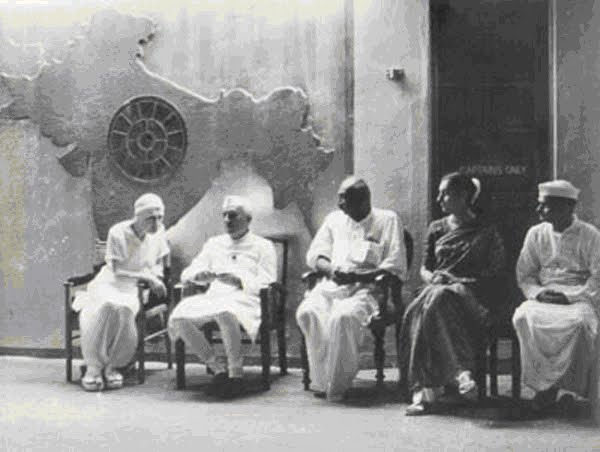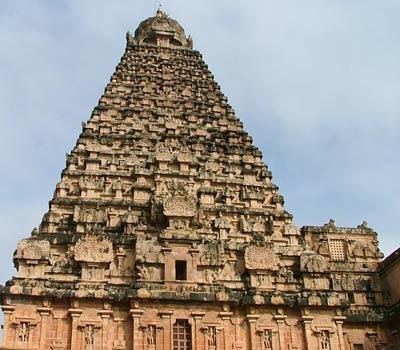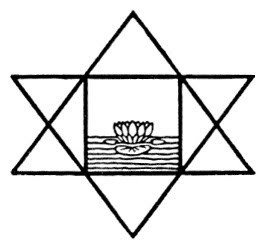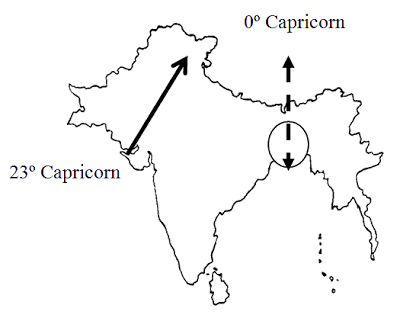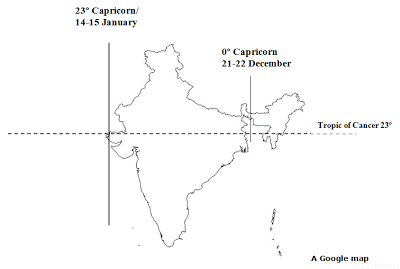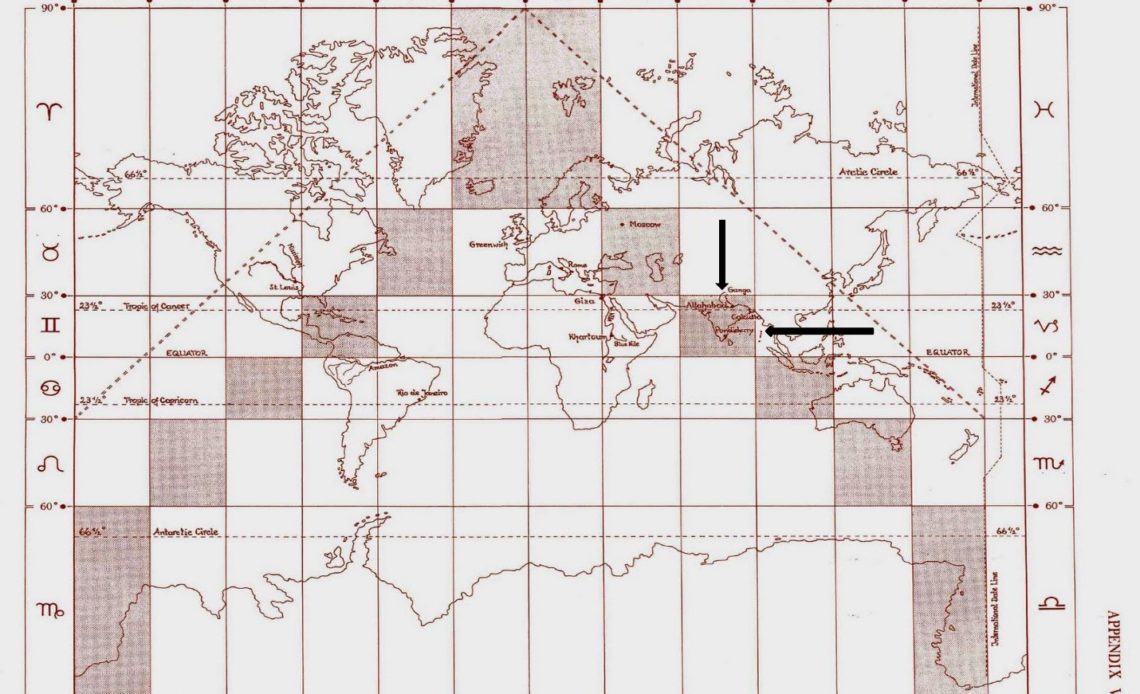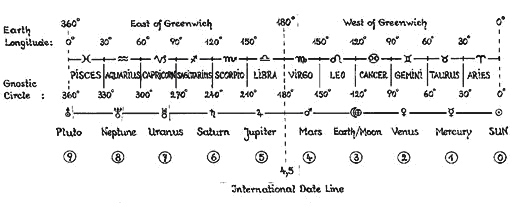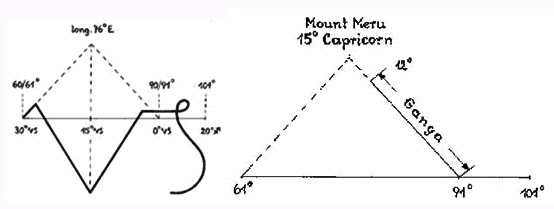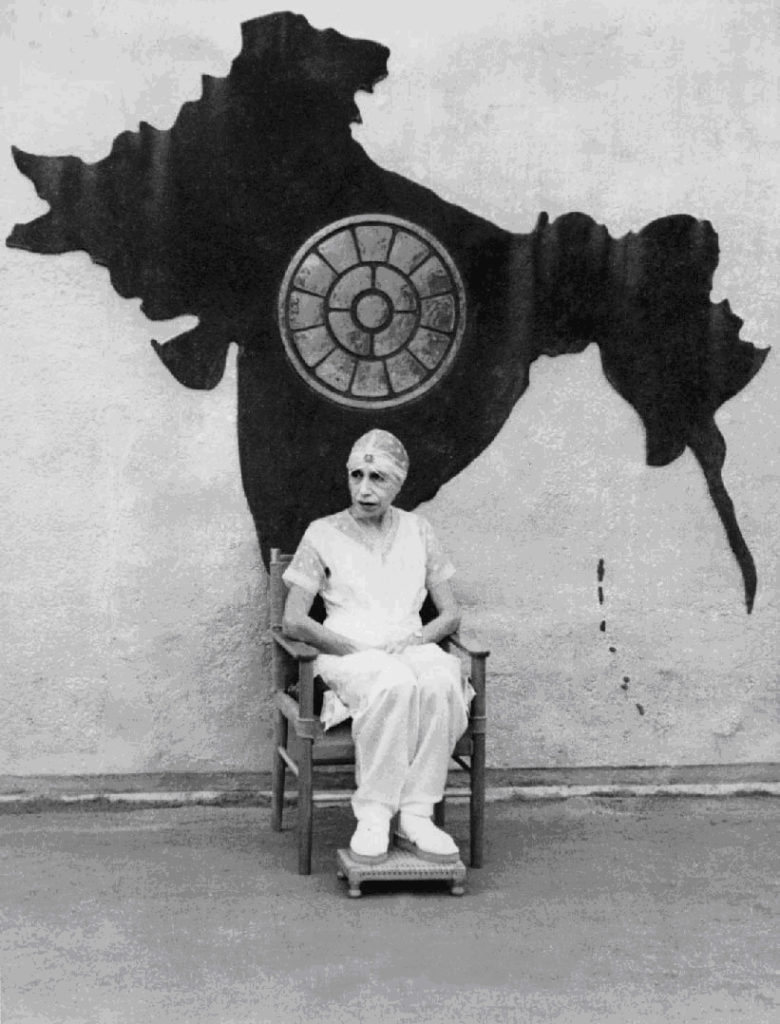Thea, Culture and Cosmos – 2, Part 3.2, Cosmic Harmonies in Hindu Civilization and Society, Volume 6 No 4, October 1991.
Cosmic Harmonies in Hindu Civilisation and Society
‘O soul of India, hide thyself no longer with the darkened Pandits of the Kaliyuga in the kitchen and the chapel, veil not thyself with the soulless rite, the obsolete law and the unblessed money of the Dakshina, but seek in thy soul, ask of God and recover thy true Brahminhood and Kshatriyahood with the eternal Veda; restore the hidden truth of the Vedic sacrifice, return to the fulfilment of an older and mightier Vedanta.’
Sri Aurobindo
Thoughts and Aphorisms
We begin this portion of the essay with a recapitulation. For this purpose, I shall present a diagram which incorporates in one design everything discussed so far. Indeed, in so doing an important service is rendered to the cause of higher knowledge by highlighting its distinguishing features. Employing just one geometric form to draw together all the elements so far analysed is the most effective means of describing the unitary, integrated perceptive capacity. This act will be engaged in throughout the remainder of our study in caste and cosmos. The very fact that a single design is capable of incorporating numerous dimensions and planes, related both to the individual and society as a whole, reveals a salient feature of the new consciousness seeking to become established on Earth: the experience of Oneness. Central to the perception lies Time. In this portion of the study, I will describe the manner in which the process of integration is carried out almost exclusively on the basis of a gnostic vision and utilisation of Time. Vast cycles are connected to the smaller, always through the same diagram. And these are rooted in the consciousness of the human being via his or her individualised ‘measure’: the Earth Year.
In the diagram (below) I have incorporated several major divisions of the circle which draw together various apparently separate branches of Knowledge, the relatedness of which may not be fully appreciated without this visual aid. The main division is fourfold. Each section combines various elements of our analysis. For example, the first of the four segments refers to caste (Shudra), and time via the first quarter of the zodiacal year, the sign/months Aries, Taurus and Gemini, or April, May and June, starting with the March Equinox. In addition there is Twashtri’s ‘Bowl’ of the ancient Vedic school in which the fourfold division refers to planes of consciousness and parts of the being, in this case the Physical. But Twashtri’s Bowl does not restrict itself to the human being. It refers to the subtle dimensions as well and the ‘being’ of a civilisation or a society. Consequently, it is intrinsically connected to caste. Each caste has an affinity with one of the subtle planes of consciousness-being which this ‘Bowl’, or the celestial sphere, describes. As the study progresses, we shall locate these divisions in the greater harmony, in the workings of evolution itself and in the movement of the Cosmic Ages. In the process, I am confident that a new perception of the destiny of India will emerge, an offshoot of which is a radically different concept of nationalism, for the latter too has its roots in the cosmic harmony.

The Uniqueness of Indian Nationalism
India is the centre of the new Aquarian Age. Given that Aquarius is a sign of Preservation or Fixed energy flow, it is the Sattwa period designated for the appearance of one of the ten Avatars in Hindu tradition. But being a ‘centre’, and the only centre of the Age, a heavy burden is cast upon India, one that sets it apart from the comity of nations. Indeed, at the heart of the matter lies precisely the question of nationhood. What, exactly, is meant by a nation; and in this special case, a nation whose destiny lies in being the ‘centre’ of the 9th Manifestation’s Age of Aquarius?
The definition is very precise and unequivocal, albeit somewhat obscure for the layman not versed in the specifics of the new cosmology. For it involves the question of cosmos, and by consequence the definition of ‘centre’ itself. The Indian nation is not merely a landmass, sacred through it may be as revealed by the application of the Capricorn hieroglyph, or tradition’s hallowed ‘Name of God’, on this landmass. It is the physical-consciousness manifestation on Earth of a new cosmos. This, succinctly, is the description of the Indian ‘nation’: a cosmic body. Insofar as the Divine Mother is that very Cosmic Body of the Brahman, we aptly refer to this landmass as Bharatmata, or Mother India. Thus, the nation is far more than the land enclosed within its borders. It is a creation on Earth of the Cosmic Truth; or, more precisely, it is a portion of the Earth upon and through which that Truth is given physical/consciousness expression. To understand this singular type of ‘nation’ demands therefore that we discover the nature of that Cosmic Truth itself. In other words, the nationhood of India is described in and by the cosmic harmonies. Inasmuch as this also describes the foundations of Hindu Dharma, it stands that as we unravel the mysteries of India’s nationhood, we also reveal the intricacies of Hindu Dharma, and vice-versa.
The heavy burden of such a destiny is obvious, for the world is not an image as yet of that high Truth. The presiding powers are agents of the Cosmic Ignorance. It is India’s destiny therefore to work out this cosmic ‘knot’ for the world, which alone can permit light to replace darkness. Thus, a true and uncontaminated concept of Indian nationalism is obliged to incorporate an appreciation of this service to be rendered, the effects of which extend far beyond the nation’s borders.
When this cosmic foundation of the Indian nation is disregarded or unknown, the result is varying degrees of chauvinism. For India, and India alone, the dividing line between the two may be thin – but, at the same time, there is a great chasm separating one poise from the other. Chauvinism, within the Indian context, is nationalism which ignores the nation’s cosmic character. It seeks to cage the national soul in the boundaries of the separative, divisive consciousness. To provide a practical example, the soul of the nation is its COSMIC substance as described in the Capricorn symbol-map of the subcontinent. The area the symbol delineates is thus the true nation. These would be or should be its borders in the higher vision of its cosmic destiny as the Centre of the 9th Manifestation.
If higher knowledge is employed in the determination of such essential issues, it is evident that the partitioned condition of Bharatmata exposes the fact that this cosmic truth was unknown at the time Pakistan was sliced out of the landmass and organised into a separate state and Bengal became divided. Similarly, Sri Lanka, Burma, and since 1971 Bangladesh, all stand as aberrations or denials of that Cosmic Truth. To have attempted to stand, integrated and whole, as a landmass united to form the Capricorn hieroglyph at the time of Independence would have meant a conscious espousal of these guidelines. Or a nationalism not tinged with ignorance as was the case in 1947. Had the nation been in a position to listen to and follow the indications Sri Aurobindo was giving from the early days of the freedom movement, the 9th Evolutionary Avatar would have been able to guide the people of India to the fulfilment of that cosmic destiny, swiftly and benignly. That is, the organisation on Earth of the Centre of the Age and the direct representative of the Cosmic Truth in the comity of nations – an element which is lacking at present. Insofar as no other nation can occupy that centre, the position stands as a void. In that ‘black hole’, energies are compressed which demand now to be released.
The totality of prevailing conditions did not permit this guidance. The result was Partition. The ‘nation’ that emerged stood as representative on Earth not of that unifying Cosmic Truth but of the Cosmic Ignorance. Indeed, the very power which has been in command of the evolutionary process for many millennia and which is sought to be vanquished.
The Vedic Dharma describes the mechanism by which the Cosmic Truth is manifested on Earth. The truncated nation we know today as India presents the world with a denial of the purest, highest expression of that Truth. The Indian ‘nation’ is simply the lived embodiment of that Dharma. That this has been denied and combated, in the effort to uphold a confused brand of secularism, is also evident in the dismembered condition of the symbol-map; while the ‘nationalism’ which seeks to take hold of the people of India in this last ennead of the millennium is simply the perception of the nation as a sacred landmass, embodying for the Earth that cosmic Truth or Hindu Dharma.
When this cosmic purpose is lost sight of, the result is chauvinism which in the Indian context is nationalism divorced from the enlightenment this Cosmic Truth provides. Thus, to awaken true nationalism in the hearts and minds of the people of India signifies that we must simultaneously unveil India’s cosmic purpose; and this in turn implies that the Vedic Dharma is revealed as the foundation of that nationalism. Since this was not the case during the freedom struggle, in the fullest terms which it is now possible to do, the result was a nationalism coloured by concepts which stood in stark opposition to the fundaments of the soul of the nation. The outcome was Partition, and since then a gradual disintegration not only of the nation’s body but also of its collective will.
The answer is therefore only one: an awakening of true nationalism which is the unveiling of the nation’s soul whose essence is the Cosmic Truth, and which, in turn, forms the indisputable foundations of the Hindu Dharma. While we continue to deny or oppose these facts, we postpone the act of integration and in the meantime we continue to suffer the anguish of diseases which have set into the body of the nation due to this denial and for which we have no cure.
Religion is not involved in this process in any way. The Cosmic Truth that is the Vedic Dharma is akin to an umbrella under which all expressions of life may take shelter. It is a synthesising, integrating agent – NOT a unity of religions but revealing a superior reality beyond religions, towards which the world as a whole is rapidly moving – a reality which stands well above organised religions of whatever brand. Partition, signifying the denial of India’s cosmic Purpose, drew into the nation’s destiny a lesser struggle for which it was ill prepared. Indeed, for which the contaminated condition of its collective consciousness had no effective means to combat or counteract. Partition, and everything that led up to it over the centuries, thrust before the nation the ugliness of the religious consciousness, a totally alien concept which came into the body of Bharatmata through a series of invasions and foreign conquests. India today continues to grapple with this alien concept. Yet lamentably the tools it uses to do so are themselves products of those alien concepts, – impotent in the extreme as elements for the unveiling of the true spirit and soul of the nation. That the intelligentsia of the country believes these concepts to be the only ones which can arrest the impending slide into a further partition and a complete disintegration of the collective will, is the measure of the success of those foreign conquests. India is thus still a prisoner of ‘foreign rule’, the meaning of which is ideologies, concepts, formulas, programmes which fail to take into account the nation’s cosmic essence and hence the true quality of the Vedic Dharma and its central place in the formation of the new India. If Islam and Christianity were the avenues for those alien concepts to take root in the consciousness-soil of Bharatmata, the method to the madness was not that they be integrated and a ‘synthesis’ emerge of the resulting cocktail. Rather, they were drawn into the nation to serve her in the process of conquering the power that feeds these limited expressions of human society and holds the entire Earth prisoner of a divisive, separative consciousness.
These concepts did not enter into the symbol-nation to enrich the Vedic Dharma but simply to provide a field in which the soul of the nation could express its cosmic purpose through a struggle which has been described in a series of epics and myths recorded in the nation’s collective memory. The finality of the struggle will be to rid the Earth of the scourge inflicted upon her by the divisive consciousness. And none can deny that religions throughout the world are tools to divide rather than unite. The seeds of the religious consciousness were thus drawn into the Centre of the Age not to conquer but to be conquered – i.e., to force the soul of the nation to stand erect and unveiled in its cosmic purpose, to unveil this before the eyes of the people of Bharat and the world.
I write these lines at a most incongruous moment, it would appear. I write as the nation seems to face a further dismembering. To appearances this is so, but it is also true that in this darkest hour of her history, India prepares to conquer. India prepares to experience for the first time in her long history of thousands of years, the fullest depths and heights of true nationalism rooted in the fully revealed precepts of its Vedic soul. This study in caste and cosmos is one more ingredient in the process of kindling the flame of that true nationalism by a revelation of the cosmic background of caste and therefore how in antiquity the Chaturvarna served as a vehicle for Indian society to express that Cosmic Truth on Earth. The decline of caste proceeded pari passu with the decline of the Dharma, and it accompanied the infiltration of alien concepts meant to hasten the collapse so that the soul of the nation could be more swiftly born.
The time has come for that birth, insofar as the Earth has become one whole, a global ‘being’. That is, the necessity for a ‘centre’ to emerge hinges on the uncovering of the periphery of the circle. Until the Earth was fully explored, and until space exploration had revealed its boundary-less condition of oneness, the purpose of the Centre could not be fulfilled. It must be borne in mind that India has always been this ‘centre’. That is, India’s role in this capacity is a development stretching over thousands of years – approximately 50,000. It has been a progressive unfolding or unveiling. This is an evolutionary process, the contours of which are provided by the Ten Evolutionary Avatars of Puranic tradition. In an explanation of the Gnostic Circle geography in Volume 2 of The New Way, I have disclosed certain elements of the new cosmology which reveal India’s predestined role as Centre of the Age, when the Earth’s entire periphery would be known and the Centre would be called upon ‘to hold’.
Fullness versus Void
Having laid the foundations for an assessment of the cosmic background of the caste system, it is important at this point to discuss briefly the elements which served to weaken the system. Not so much because, in the view of certain religions, it was an inhumane treatment of a large segment of the society, but because those religions opposed the cosmos itself. Hence caste became a target for their attacks.
The case of Buddhism is quite clear. While Buddhism did not directly bar the cosmos and material creation from its vision of reality, it did plant the seeds for a slow and steady decay in the spiritual dimension of Vedic civilisation by a remarkable process of undermining. This was achieved through the introduction of a certain realisation which in itself served as the undermining agent. It was the dissolution of the consciousness (Nirvana), whereby the nexus binding the individualised consciousness to the planet and the cosmos, as an integrated, vibrant particle in the network of time and space, was disintegrated. The result was moksha or ‘liberation’. Hence it is held that Buddhism denied the existence of the soul, for indeed it is this component of the human incarnation which provides the link between cosmos and man. The Cosmic or Universal Purush is thus a description of that supreme Atman or Soul through which the microcosm (multiple souls) is equal to the macrocosm. Caste was a system whereby the entire society became the reflection of that greater harmony by organising it in such a way as to provide the Cosmic Being with every possible channel of expression for its evolutionary purposes. Each section of the ‘circle’ embracing the four castes was intended to be the collective instrument for that superior, integral manifestation.
The Purush is the cosmic Soul. The individual born on Earth partakes of the macrocosmic by embodying in the physical universe a spark, shall we say, of that all-encompassing Flame. Time is the essence coursing through this network, as breath rushes through the body, and it utilises the soul for creating a cosmos; or, in a succinct description of our world: a unified multiplicity. Consequently, two features of caste cannot be overlooked in a truly deep study of the matter: time and cosmos. Both hinge on the soul and the part it plays in the physical universe in this act of harmonising and integrating.
Thus, if the Buddha undermined the soul’s central position in the civilisation, it was only a matter of time before the edifice of caste would collapse. However, it did not collapse entirely, as history records and an assessment of present-day society affirms. Rather, as Sri Aurobindo wrote in the early part of this century ‘…old names and formulas have been preserved while the thing itself was profoundly modified until its original sense remained only as a pious fiction.’ (TVN, 6/2, p. 31.)
Referring to our diagram on page 16, we may situate the soul at its central Point, the centre without which ‘the circle cannot hold’. The Point or the Soul having been undermined, the channel which feeds the periphery and the infinite diverse segments of the circle was attacked. Seepages of energy began, drains on the system. Buddhist practice and related methods of ‘liberation’ secured in India that the Centre would no longer hold the periphery together or be the bridge to the Cosmic Fullness of the Mother. Rather, it would be the shadow of that Fullness, – i.e., the Void.
In practical terms, in the spiritual world this introduced the first perceptible seeds of what was to develop fully later, in Shankara’s time: an almost complete split between Spirit and Matter in the perception of Reality and the experience of yoga. The Spirit was no longer experienced through the channel of the Soul, or the Mother, but rather, in a series of yogic realisations which in varying degrees continued the process initiated by the Buddha in his experience of Nirvana, the seeker was encouraged to overstep the Cosmos as Sri Aurobindo has explained:
‘…But in speaking of the supreme liberation I was simply taking the Buddhist-Adwaita view for granted and correcting it by saying that this Nirvana view is too negative. Krishna opened the possibility of overmind with its two sides of realisation, static and dynamic. Buddha tried to shoot from mind to Nirvana in the Supreme, just as Shankara did in another way after him. Both agree in overleaping the other stages and trying to get at a nameless and featureless Absolute. Krishna on the other hand was leading by the normal course of evolution. The next normal step is not a featureless Absolute, but the supermind. I consider that in trying to overshoot, Buddha like Shankara made a mistake, calling away the dynamic side of the liberation. Therefore there has to be a correction by Kalki.’
‘Letters on Yoga’, p. 402-3
The consolidation of these realisations in the spiritual evolution of Indian society had the devastating long-term effect of undermining the cosmic bridge, the soul, and all that this signifies for a creation in matter. The soul was thus the target; in the terminology of the new cosmology, it is the Third in the descending scale of 9-6-3-0/1. If the 3 (the soul) and the 6 (the Mother) are eliminated, the realiser shoots from the 9 directly to the 0. In that case, without the ‘fullness’ of material creation in between, the 0 stands as Shunya, or the Void. It has not thrown up the One, the divine Son Agni. In a word, it is an incomplete perception of Reality, entirely un-Vedic, with devastating results on the society that embraces these concepts, driving it to devise evermore sophisticated means of escape. Again, Sri Aurobindo writes…
‘According to both Buddha and Shankara liberation means laya of the individual soul in some transcendent Permanence that is not individualised – so logically a belief in the individual soul must prevent liberation while the sense of misery in the world leads to the attempt to escape.’ (Ibid, p.66.)
Returning to our diagram once again, this process can be visually appreciated if we locate the area of dissolution or annulation OUTSIDE the periphery of the circle. In that realm there is no individualised consciousness. The nexus or the binding energy that constitutes the soul is dissolved (‘nirvana’). Thus, the embodied consciousness of such an individual, who in the proper terms of the experience can no longer lay claim to that title, does not offer sufficient concentration of energy to serve as a channel on Earth for the influx of an integral flow. In other words, the individual is no longer centred, no longer poised at the centre of the influx and harmoniously aligned so that he or she may express that totality. The centre is a void and the binary structure of an incomplete energy base is the result. Such individuals or the society they form can never be the instruments on Earth of a divine manifestation:
‘What are you going to do with all these people? If you want Nirvana, you have either to expel them or stifle them or beat them into coma. All authorities assure us that the exclusive Nirvana business is a most difficult job…and your own attempt at suppressing the others was not encouraging, – according to your own account it left you as dry and desperate as a sucked orange, no juice left anywhere. If the desert is your way to the promised land, that does not matter. But – well, if it is not, then there is another way – it is what we call the integration, the harmonisation of the being. That cannot be done by the mind and vital being – they are sure to bungle their affair. It can be done only from within by the soul, the Spirit which is the centraliser, itself the centre of these radii…’ (Ibid, p.53.)
Fullness versus Void is most clearly expressed in the art Buddhism and Hinduism have inspired. Pure Buddhism, not influenced by Tantra, is bare, placid, revealing no other state or emotion but a static Peace. On the other hand, Hindu art and temple architecture offer always exuberant displays of the Fullness; and, above all, dynamism. Even its representations of Peace in certain creations depicting Shiva, for example, are dynamic and serve to convey one of the highest experiences available to the practitioner of the Integral Yoga – the supramental state of a harmonised unity and multiplicity, or the simultaneous experience of rest and motion. For the whole of society it would be the correct blending of Stability and Change. This would be the true VEDIC experience, shorn of these intermediate developments, in the fullest sense of the word: veda meaning knowledge: a Gnostic Society.
‘…The harmonisation is in the Supermind – the Divine Truth at once static and dynamic, a withdrawal and extinction of the Ignorance, a recreation in the Divine Knowledge.’ (Ibid, p.79.)
Most spiritual realisations offer the seeker only unity, or rest, or stability. Change, movement, dynamism became equated with a lesser deceptive power whose objective it was to imprison man within that Circle where movement is perceived as the impermanent and hence the unreal, impeding his escape to the Beyond by entangling him in the coils of a ceaseless, inebriating motion, an entanglement in what has come to be known as the veils of Maya or Illusion. Escape can be achieved only on the basis of the experience of Dissolution or disintegration of the consciousness in one form or another by a prior denial of reality to that deceptive conspiracy of circumstances labelled samskaras, or one’s fixed responses to past patterns within the web of time and space.
This development or emphasis reached a peak in the Middle Ages. If we refer to our diagram again, Hindu civilisation quickly became the shell of itself once the Soul had been dislodged from its central binding throne, once the Point had been rendered an empty space.
Hindu Dharma was ill prepared to contend with the consequences of Nirvana, having no recourse to dogma, to bigotry, to expulsion or excommunication. The foundation of the Dharma was unity, and the lived perception and experience of the One embracing the All. Therefore its response was the only possible one if wise men and women in that dark period of the Age of Pisces were to be faithful to the Vedic foundations of the Dharma. Their reaction was thus to incorporate the Buddhist realisation, for it was the lived experience that the Brahman included everything, even the darkness. At the same time, they knew that even if contained in the All, Nirvanas and Voids were underminers of the Atman.
Hence the Buddha was incorporated into the Puranic Line of the Ten Avatars, but his participation was a qualified one: the ruse of the Supreme meant to mislead the asura-seeker. This incongruous description for an Evolutionary Avatar of the Line points to two facts: one is the all-embracing nature of the Vedic perception, and the other indicates that perhaps the decline was anticipated and accepted and foreseen in the renovating mechanism of the Dharma as a means to attain greater future manifestation. That ‘fall’ was seen as a necessary corollary to a future rise. In the terms Sri Aurobindo provides, the wider harmonisation which only the present Age of the Supermind can unfold.
But the results of the decline were fast in coming. Thus, in the early 700s the subcontinent witnessed the first invasion from the west. The seeds of Islam were brought into India as a perfect symbol of the denial of the soul which had already become consolidated in the civilisation by that time. The capacity for Islam to serve as this symbol lay in the fact that one of its pillars of the faith is the condemnation of idol worship. Given the proliferation of Hindu Gods and Goddesses with their many arms, vahanas and whatnot, it is clear that Islam’s almost complete denial of FORM, or the Mother who is the FORMATIVE POWER of the Brahman, would present a chasm between the two civilisations which has never been bridged, partly because most do not realise what it is that really separates the two. The compulsive destruction of Hindu Temples by these invaders and their replacement by mosques is simply a very physical albeit brutal means to affirm the supremacy of a religion which has radically veered toward the masculine pole in its perception of Reality, and which, when denied the companionship of the Feminine, is able to espouse a vision of God entirely formless.
The undermining Nirvana and similar realisations set in motion simply served to dissolve the energies which could have coped with the invasions. At the same time, we must admit that Islam was merely fulfilling its own dharma via those relentless incursions into the Body of Bharatmata. Thus, no blame can be attached to their bold thrust. Nonetheless, we must realise that the conquests by these foreign powers were simply reflections of that inner disintegration. From the standpoint of the conquered, it ought to be stressed once again that the purpose was to queer the pitch, as it were, to heighten tensions. It was a divine strategy to play out before the civilisation the results of an original denial of the soul.
This play-out has been central to Indian life for the past 2000 years. With each passing year the results of the great Undermining became more and more devastating because the imbalance of energies was accentuated. Today the nation has no energy/will to eject definitively the viruses from its sacred form which are the offspring of those original ‘seeds’ planted so long ago.
Half-lights of History
In the June 1991 VISHAAL (6/2), I discussed at length the areas in the physical landmass through which invasions took place. By the application of the Capricorn hieroglyph, I pointed out how perfectly in tune they were with the cosmic harmony, albeit negative expression of that harmony – that is, representing Vedic civilisation’s decline and the disintegration of its collective will. I repeat, having begun more than 500 years prior to the first invasions from Arabia, by the Middle Ages the inner disintegration was such that invasions could not be conclusively repelled. Historians speculate endlessly about the underlying causes of India’s inability to contend successfully with these invasions. Many consider the degeneration of the caste system to be the principal reason, or at least one of the main expressions of the inner decay and subsequent collapse, presenting the invaders with a society at war with itself and unable to unite its forces due to an inherent divisive quality in the system itself, where the four castes were not complements but antagonists. However, this is only partially true.
To begin with, I find the reasons given for the degeneration of the caste system to be entirely unsatisfactory. The prevalent view is that the preponderance of the priestly caste caused the structure to collapse under the weight of this sacerdotal despotism. While I might attribute the decline to that segment of the society, the reasons I give are quite different. Such a system, founded on a SPIRITUAL perception, can disintegrate only when that perception has been corroded. And this was exactly the case.
Be this as it may, the fact is Hindu civilisation could not contend with Arabic, Persian and Moghul invasions. Within a span of several hundred years, and though greatly out-numbering the aggressors, almost the entire subcontinent came under foreign rule and Islamic influence.
The problem lay in the fact that the unifying power of the subcontinent, the binding force of Hindu civilisation, was the Dharma. Thus, in spite of the fact that there was no POLITICAL unity meeting the aggressors, with the subcontinent presenting a very disunified appearance, it was the Vedic Dharma that made of India a unified civilisation, entirely unique and not to be found anywhere else on the globe in ancient times. India was a ‘nation’ regardless of the separate kingdoms the subcontinent housed.
As already established, the Cosmic Truth is central to that Dharma; the soul is, in turn, central to the Cosmic Truth. With the denial of the soul, and by consequence the denial of the Mother or the Formative Power of the Brahman, it is understandable that Islam and later Christianity – religions which both nurture an aversion to form as demonstrated in their condemnation of idol worship, labelled paganism – moved into the subcontinent with relative ease, except for isolated periods and incidences of effective resistance here and there. The latter, however, were not conclusive or all-encompassing enough to protect the Body from an implantation of divisive elements in the system which would take decades and centuries to eliminate.
The degeneration of caste was thus contingent on that original denial and undermining. Indeed, it was a wave which, in a very brief span, engulfed the entire planet. The Age of Pisces, dating from 234BC to 1926AD, witnessed the almost complete collapse of one element which in itself encapsulates the entire process described above: the prominence of the Mother or the Goddess in almost all philosophies, belief systems, schools of yoga, and cults of worship. In a word, the dismantling of the ancient world which in its entirety could be labelled ‘pagan’ since the Goddess was indubitably central to all belief systems that in the Piscean Age earned that label.
With the spread of the Middle-Eastern religions, in particular the proselytising ones such as Christianity, the Goddess and all that the Feminine Power stands for in the collective consciousness of the Earth, was almost entirely dislodged from the elevated status she had always held. The symbol of this displacement was the simple act of condemning idols, a tenet shared by all the young faiths which emerged from the Age of Pisces. Accompanying this displacement was a loss of perception of the sacredness of the Earth itself, – indeed, mother Earth. This too was reflected in the new tenets in a blanket condemnation of ‘nature worship’, a corollary to ‘paganism’ in theology, and ‘animism’ in philosophy. Both carried the connotation of uncivilised and barbaric. By implanting this sense of inferiority in the masses of the subcontinent, conversions to the new religions were easily achieved, its corroding power being far more potent than the discriminations of caste. These incursions into the core of Vedic belief, affecting especially the elite of the society, was to peak in the 19th and 20th centuries.
Thus, the seeds of the great Undermining which began at the outset of the last Age, the first of the three which comprise our 9th Manifestation, allowed for two different though related foreign conquests in India, Islamic and Christian. The former signified military subjugation above all else, in keeping with Islam’s character. Islam, being so utterly different from Hindu worship and culture, posed little danger of invading and replacing the indigenous philosophies and cultural substratum of Hinduism, or even contaminating it in any essential way. Conversions were effected by force or otherwise, but these did not strike at the core of the unitary consciousness which pervades Hinduism, primarily because Hinduism was not a religion as Islam was. The twain could therefore never really meet or mutually influence each other in substantives.
The situation regarding Christianity was quite different. It was not Christian religion that conquered or made definitive inroads into Hindu civilisation. Rather, it was the consciousness which had overtaken the entire world as a result of Europe’s colonial exploits. Christianity, with its dogmas of faith and discomfort in dealing with matters material and of the flesh, had forced the rise of science (as separate from pursuits of the spirit), rationalism, the logic of the Age of Reason and ‘enlightenment’. And finally a worldview entirely overshadowed by a materialism divorced from the more subtle influence of the Spirit, – a split unknown in the ancient world and even, though greatly reduced in vigour, in India at the time of the appearance of the traders/conquerors from the British Isles. These are the ‘seeds’ that Christianity planted through British rule, stressing, as we must, that this rule occurred not at Christianity’s peak of influence but rather at a time with the seeds of its own decline were evident. And the conquering continues though the conqueror has left because the consciousness that invaded India was ‘secular’ and bore profound affinities with the ancient Indian spirit.
The Indian mind, while not enjoying any particular affinity with Islam, was entirely at ease and comfortable with the ‘scientific temper’ and with ‘secular’ concepts, – these having been part and parcel of India’s ancient culture and civilisation millennia before the appearance of these latter-day secularists and scientists. Rationalism, logic, science, the demand for empirical proof and practical substance which characterise all schools of Indian yoga, founded on direct experience rather than blind faith, were part of Indian civilisation before the advent of Jesus. When these attitudes arose in the West as a reaction to religious dogmatism and obscurantism, they were easily accepted in India of the 18th, 19th and 20th centuries, insofar as they were concepts closer to the character of Indian philosophy and systems of yoga than any religion might be.
Thus, the two waves, Islamic and Christian, each in their own way continue to ‘conquer’: Muslims, with their demand for a dismembering of the subcontinent on the basis of religion at the time of Independence, and presently with a rise in Islamic fundamentalism which, in the form of another wave from the West, has stoked the fires of secessionism and has not ceased to encourage a sense of instability, a nation perennially threatened with a new partition. While the brand of secularism which the West firmly planted in the consciousness of the elite of pre- and post-independent India through British conquest and influence is a constant underminer that does not allow the nation to appreciate its own soul and the deepest truths of the Vedic Dharma. This is attainable only when the true nature of Hinduism is explored and its unreligious character is discovered. In other words, the western concept of secularism, introduced in Europe because of a necessity to counteract the dominance of religious obscurantism, is inadequate to contend with the fissiparous forces at work in the subcontinent. Western secularism cannot unify because the seed of its own origin is divisive. It was an entirely reactionary formulation, with no inherent and substantial power and truth; unlike the Vedic Dharma founded on the Cosmic Truth.
Caste, Time and the Calendar
The first appreciable casualty in the loss of the cosmic vision was the caste system. When the Beyond became the goal, and life in the cosmos and on Earth was held to be a prison of consciousness, the spherical perception disappeared and in its place remained caste as a linear, pyramidal structure (see: TVN 6/3, diagram p.24). In the very same period, Hindu civilisation lost its vision of an enlightened perception of Time, a development which I have discussed in ample detail in the series ‘The Capricorn Factor’ (TVN 2/4, 2/5). The Divine Maya or Measure was lost and this had a direct effect on caste because caste and time are quasi synonymous. That is, without the Divine Measure there can be no Cosmic Purush reflected in a society on Earth, integrated in all its parts, each limb or organ supporting the other limbs and parts of the Being. Nor could there be any all-encompassing fabric integrating the diversity that has always characterised the societies of the subcontinent. Time provided the means to achieve this integration. Hence, the means to record and regulate the flow of time in a cosmic society is fundamental. We understand, therefore, why the Year occupied such a central position in the knowledge of the Vedic Age (and also in Mayan America), as revealed in the extant hymns of the Rigveda and the Atharvaveda. The Rishis were forever singing praises to the various components of the Year, – the seasons, the periods of the 24-hour day such as the dawn, the night; or else the elements which are energy manifestations within that time structure: fire, earth, air and water, elements which Time uses to give form to consciousness.
It must be borne in mind that the diagram by which we have integrated all the elements of our discussion (p.16) – or the circle of 360 degrees divided into four – is also the year. Thus, Shudra, Vaishya, Kshatriya and Brahmin can also be allocated to a portion of the Earth Year. This means that there is a beginning and an end, a 0 point and a 360-degree point to both the year and caste. It means that while 90 degrees of the 360 comprise three months – those of Spring, for example – they also ‘comprise’ the Shudra in the collective Body. It means that the twelve months of our Earth year and the calendar we devise to monitor the passage of time within that span are intrinsically related to caste and are essential to its right functioning. Given the disintegration of caste, whereby only its shell remains, and the proliferation of divisions within each segment which are indications of the degeneration, it is not surprising that we should find the same process to have afflicted the methods for a collective systematisation of the time experience: the calendar. India today does not possess just one calendar; there are many. Almost each State and community have a different system of reckoning, as well as each religion – Islam, Christianity (the Gregorian calendar in use throughout the world), Zoroastrianism, Sikhism, and so forth. There are five principal methods employed; that is, some may use the lunar year, some the solar. In addition, there are 300 almanacs in use throughout the country, each different from the other, each catering to the needs of the different communities.
The Cosmic Truth, which uses time via the Divine Measure for its binding and formative creative operations, is reflected in the calendar. An enlightened calendar is the hallmark of an enlightened society. This means a calendar which comes as near as possible to aligning society with the Cosmic Truth unrolling through the flow of time during the Earth year. Thus, we can easily appreciate why the Rishi declared in the Rigveda, ‘Certain eternal worlds are these which have come into being, their doors are shut to you (or, opened) by the months and the years; without effort one (world) moves into the other, and it is these that Brahmanaspati has made manifest to knowledge.’ (II,24-5)
The essential feature of that superior alignment was the correct zero point, or the start of the year, which then set ‘each thing in its place’ as time moved on in the course of the ensuing twelve months. If that 0 point was miscalculated or otherwise tampered with, the flow was disfigured accordingly and time’s ‘gestation’ produced either a stillborn or maimed creature. A society that had lost that correct calculation of the 0 Point could not hope to experience any significant harmony within itself or integration of its diverse limbs, not to speak of a proper relationship with the cosmos, since the act of integration hinges on the correct ‘axis’ or ‘alignment’. In the Veda and the earlier Upanishads, this ‘axis’ was the property of the God Agni.
Before proceeding further, a word ought to be said about the proliferation of symbols, personifications of the Gods and their carriers via animal or other images in India, since this practice is one that divides contemporary society from almost all ancient civilisations. In all parts of the world there has been a complete break with this ancient form of conceptualisation. India is perhaps one of the few nations today where we find that this practice is still a vibrant part of the country’s cultural and spiritual life, given the fact that myth, epics and, above all, the still prevalent guru/disciple parampara or tradition, are vigorous ingredients in the socio-cultural fabric. The need to transmit knowledge in this fanciful manner was not a frivolous indulgence of a pagan, nature-worshipping and naïve mind. Rather, that the Seers of the Vedic Age (and rare modern visionaries) chose to frame their knowledge in this way was an indication of a very high degree of sophistication. The purpose was to achieve an integral seeing. For example, this meant that the use of Number alone, or even the enlightened use of diagrams as a means of transmitting facts about matter, time and the cosmos, could only appeal to and develop the mind without engaging other equally important parts of the being and planes of consciousness. Hence, they were not adequate if exclusively utilised, as we do today, for the transmission of concepts. Indeed, in so doing the result is information leading to the manipulation of those facts, never an understanding of the integrality and oneness of our world and the interconnectedness of its many planes and dimensions. Number might appeal exclusively to only one of those planes – the mental; while the animal image, for example, drew in the visualisation capacity of the human consciousness, the art of seeing, and hence the vital to a large extent.
Or else there was the utilisation of hieroglyphs, for instance of the twelve signs of the zodiacal year – a highly sophisticated means of transmitting knowledge which drew into the exercise the higher mind and higher vital centres. Today this capacity to see in such an integral fashion is entirely lacking. Consequently, there are no seers, no Rishis.
Let me provide an example of the above which illustrates the capacity for ‘seeing’ in an area connected to the present topic under discussion: the calendar related to caste. Agni’s vahana or carrier is known to be the Goat. This image must not be construed as a meaningless designation born in the mind of pagan nature-worshippers, for the Goat in Agni’s imagery refers to the Year and the correct alignment under discussion. There are two complementary 0 points which describe the Divine Measure and bear a very special relevance to the act of ‘setting each thing in its place’. One is the Ram 0 point, or the first zodiacal sign Aries, and the second is the other goat image, Capricorn, the tenth sign/month. In terms of number-power they are both 1 – the 10 simply being the 1 after the completed cycle of 9 numbers; 10 starts the new cycle and is, numerologically speaking, a 1. Both correspond to the power of the Son, or the One: the divine Agni.
Hence, the Vedic ritual may begin (and end) with an invocation to Agni, first manifestation of the Gods, first of the elements (fire=Aries), ‘leader of the hosts’ in his aspect of Mars, ruler of Aries; Mesham, in Sanskrit, the first month. These correspondences are found throughout the hymns. Thus to ignore the zodiacal character of the Rigveda is to deliberately and wilfully seek to thrust upon this bedrock of Hinduism a character which is entirely foreign to its true nature and purpose. This was indeed the case when 19th– and 20th-century Indologists sought to cram the Veda in the entirely inadequate slot of History. That they succeeded in doing so is the measure of success of the contamination set into the Indian mind via the western secular onslaught.
After Aries – first sign or first manifestation of Agni/Mars – the ‘journey’ or the ‘sacrifice’ brought the initiate to the 10th sign/month/’door’ and entry into Swar, the realm of the Truth-Consciousness. But this passage was not a simple matter. It was fraught with danger, for it involved the 8th stage, Scorpio, also ‘ruled’ by Mars; it was then that the real trouble began – in the imagery of the Veda, the rescue of the cows (rays of Light, or Knowledge) from the cave of the Panis. Scorpio is the sign of Death in traditional astrology. It was the same in the Vedic Age, ample proof of which is given in the references to Martanda, the eighth son of Aditi, the ‘fallen star’, whose very name comes from the root meaning death.
If the energy of Mars is not transmuted or released (the ‘release’ of the cow/rays), death meant the obliteration of the consciousness and disconnection with the physical plane. It meant that the ‘victory’ in the 10th month of Capricorn, traditionally known as the exaltation of Mars, could not be achieved on Earth and connected to its evolutionary processes, but only in ‘heaven’. The decline of the Dharma saw this drama enacted in full, with spiritual energies posited in that ‘heaven’ beyond and withheld from a process which alone could unify and conquer on Earth.
On the other hand, when the Mars transmutation occurred and the Sacrifice was ‘pleasing’, the energy was released which provided fuel for the rise to the mountaintop or the sign/month Capricorn, India’s very own zodiacal ‘ruler’, according to tradition the world over. Interestingly, at that point Agni became the Horse, the white steed – indeed, horse-power. This was indicated by the 9th sign sandwiched between Scorpio and Capricorn: Sagittarius, precisely the sign of the Horse. And in order to emphasis the Earth-oriented essence of the realisation, rather than a heaven beyond of a dimension outside of this cosmos and our material creation, that immaculate Steed which is Agni transmuted, is the vahana of none other than Usha, the divine Earth-Dawn. Agni, as the Horse (9th sign/month), ushers in the Dawn, be it of the Earth day, or the year or twelve months, or the cosmic year of many thousand months.
We may now refer to our diagram on page 16 and locate this process of transmutation, of conquering, in the third segment of the Circle – the Kshatriya. In so doing, we instantly confirm the connection between caste, time, the calendar and the Vedic Dharma. To provide even more conclusive proof, it may be recalled that an aspect of Agni is the Hindu War God Kartikeya. His birthday is celebrated precisely in the heart of this Kshatriya segment: late November, or with the correct 0 point, in the sign/month Sagittarius. In Sanskrit the month is known as Kartik.
Thus the Rigveda, the oldest book in the world and foundation-seed of all that is contained in Hindu culture, establishes a remarkably rich and poetic connection between cosmos, time, year, Earth – and caste. The only problem is that the great Undermining produced the unfortunate result of a loss of the Divine Measure. Contingent upon that loss is the lack of a single calendar uniting the collective consciousness. There is not one but dozens, and each has a different 0 or starting point. Hence, though these multiple calendars may still use the backdrop of the 360 degrees of the celestial sphere and the division of that sphere into 12 segments or months, initiating their counts at different times reflects the inability of Indian society to become integrated. Indeed, for a person of Knowledge it is as if one were observing the unfolding of present-day Indian society through a painfully unfocussed lens: no matter how hard one tries, clarity just will not attend one’s efforts. The chaos brought before one’s vision is simply another indication of that lost Measure. Notwithstanding the fact that at the time of Independence the Gregorian calendar was adopted for official purposes in order to align India with the rest of the world, the different communities and religions continued to use their own methods of reckoning. Any attempt to bring about a ‘focussing’ in this time-lens would be similar to the demand voiced by certain quarters for a uniform civil law code, whose adoption is also hotly contested by communities which view such a step as a threat to their ‘separate identities’. In fact, a true discussion of caste and cosmos is, by definition, precisely one of identity, of essential truth of being, of individual and collective dharma. This aspect of the study will be explored further on.
To return to our discussion of the stages of the Vedic Sacrifice, or progression through the year, we note that passage through the 7th, 8th and 9th stages, or the Kshatriya/warrior caste segment, was considered crucial. Indeed, in the successful ‘crossing’ of this zone lays India’s ability to survive as a nation and a civilisation. But to appreciate how this may be and what connection these ancient prescriptions may have with contemporary Indian society, we must expand our time vision and study the Chaturvarna on the backdrop of the larger measures of time, the cosmic Ages, or, as I have called them, the Twelve Manifestations. In this way we shall appreciate why it is that the 7th and 8th Avatars, and indirectly the 9th, have come to such fierce prominence of late, through the contentious issue of ‘temple or mosque’ at Ayodhya, and how this issue is singularly reflective of the grand Sacrifice described in the ancient Rigveda as precisely involving the 7th, 8th and 9th stages of the Journey. And by this interrelated seeing, we shall discover how the last three decades of the millennium, the 70s, 80s and 90s, have recapitulated or condensed in this very special time span the Vedic passage through the most dangerous and determining portion of the Circle.
As we proceed with the next portion of the study, once again we engage in that magical feat of harmonisation and integration, whereby caste and time continue to reveal the profound truth in the Hermetic aphorism, ‘As above, so below’. This further act of perceiving the equality of macrocosm and microcosm will assist us in drawing together these multiple time-threads in a concentrated focus on caste within contemporary Indian society, in its individual and collective expressions; and what might be its relevancy to the civilisation that gave it birth, if any at all.
P.N.-B.
August 1991
Aeon Centre of Cosmology
at Skambha


